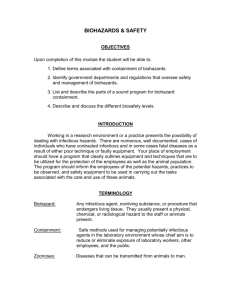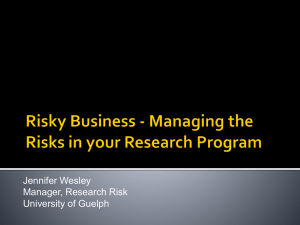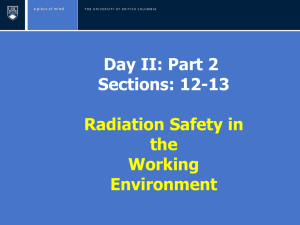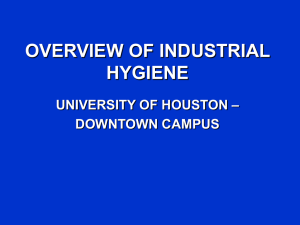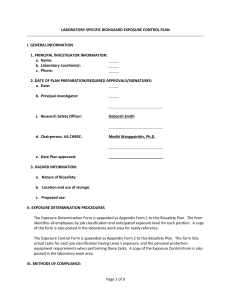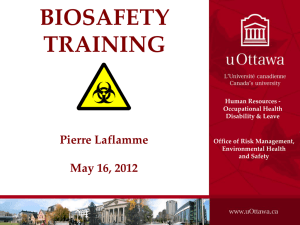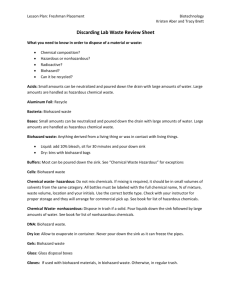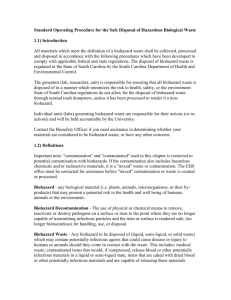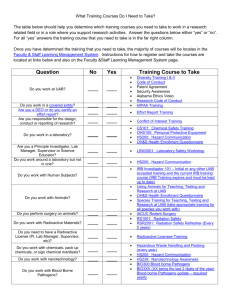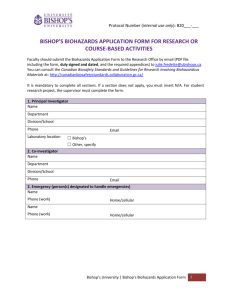Biohazard Risk Assessment & Management: A Guide
advertisement
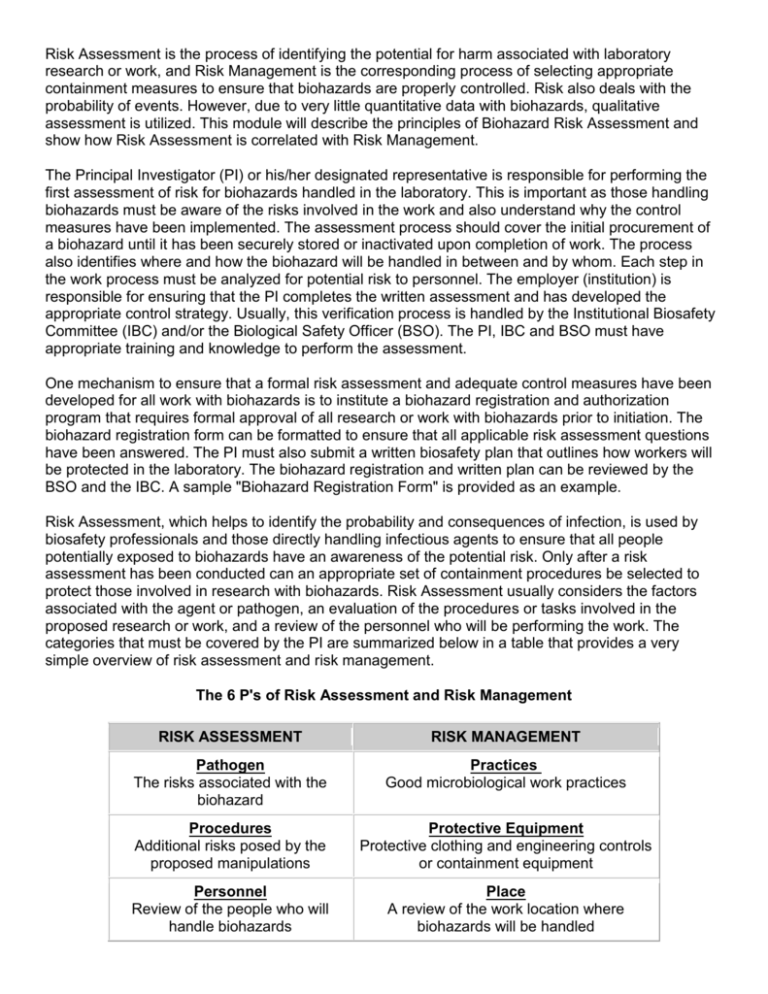
Risk Assessment is the process of identifying the potential for harm associated with laboratory research or work, and Risk Management is the corresponding process of selecting appropriate containment measures to ensure that biohazards are properly controlled. Risk also deals with the probability of events. However, due to very little quantitative data with biohazards, qualitative assessment is utilized. This module will describe the principles of Biohazard Risk Assessment and show how Risk Assessment is correlated with Risk Management. The Principal Investigator (PI) or his/her designated representative is responsible for performing the first assessment of risk for biohazards handled in the laboratory. This is important as those handling biohazards must be aware of the risks involved in the work and also understand why the control measures have been implemented. The assessment process should cover the initial procurement of a biohazard until it has been securely stored or inactivated upon completion of work. The process also identifies where and how the biohazard will be handled in between and by whom. Each step in the work process must be analyzed for potential risk to personnel. The employer (institution) is responsible for ensuring that the PI completes the written assessment and has developed the appropriate control strategy. Usually, this verification process is handled by the Institutional Biosafety Committee (IBC) and/or the Biological Safety Officer (BSO). The PI, IBC and BSO must have appropriate training and knowledge to perform the assessment. One mechanism to ensure that a formal risk assessment and adequate control measures have been developed for all work with biohazards is to institute a biohazard registration and authorization program that requires formal approval of all research or work with biohazards prior to initiation. The biohazard registration form can be formatted to ensure that all applicable risk assessment questions have been answered. The PI must also submit a written biosafety plan that outlines how workers will be protected in the laboratory. The biohazard registration and written plan can be reviewed by the BSO and the IBC. A sample "Biohazard Registration Form" is provided as an example. Risk Assessment, which helps to identify the probability and consequences of infection, is used by biosafety professionals and those directly handling infectious agents to ensure that all people potentially exposed to biohazards have an awareness of the potential risk. Only after a risk assessment has been conducted can an appropriate set of containment procedures be selected to protect those involved in research with biohazards. Risk Assessment usually considers the factors associated with the agent or pathogen, an evaluation of the procedures or tasks involved in the proposed research or work, and a review of the personnel who will be performing the work. The categories that must be covered by the PI are summarized below in a table that provides a very simple overview of risk assessment and risk management. The 6 P's of Risk Assessment and Risk Management RISK ASSESSMENT RISK MANAGEMENT Pathogen The risks associated with the biohazard Practices Good microbiological work practices Procedures Additional risks posed by the proposed manipulations Protective Equipment Protective clothing and engineering controls or containment equipment Personnel Review of the people who will handle biohazards Place A review of the work location where biohazards will be handled Pathogen It is important for all employees with direct exposure to a biohazard to have a solid understanding of the infectious agent involved. Key agent factors include the route of exposure and the signs and symptoms of infection. Knowledge of how an infectious agent can enter the body helps identify the barriers and practices that must be used for protection. Researchers handling high risk biohazards must also report any illness that may be related to those of the disease under study or one that causes absence from work. These circumstances require prompt evaluation by the institution's medical health professionals. Other risk assessment factors include the agent's pathogenicity (ability to cause infection) and virulence (the severity of disease), the infectious dose, the availability of prophylaxis, communicability, and stability within the environment. Many government and regulatory agencies have developed formal Risk Group classifications for infectious agents based on various risk factors. A good starting point for assembling the information needed to conduct a risk assessment is the home page of the American Biological Safety Association (ABSA) at www.absa.org. Once on the ABSA home page, open the "Biosafety Resources and Tools" link, for access to the following documents or tables: Material Safety Data Sheets (MSDS) Infectious Substances o Laboratory Centers for Disease Control – Canada Risk Group Classification for Infectious Agents o Bacteria – Viruses – Parasites – Fungi Risk Group and Biosafety Level Definitions The Risk Group Comparison Table from Module 1 is reprinted here and outlines the basic differences between each of the Risk Groups. Risk Group Comparison Risk Group 1 Characteristics Does not cause disease in healthy adults Risk Group 2 Risk Group 3 Risk Group 4 Can cause infection of varying severity. Rarely lethal Agents associated with moderate to severe disease outcome. Can be lethal Capable of causing severe disease with lethal outcome Availability of Treatment Not applicable Treatment Treatment may usually available not be available or host immune system is capable of controlling the infection Treatment is generally not available. Experimental treatment regimens possible. Routes of Transmission Not applicable Ingestion, through the skin, and via facial mucous membranes Same as Risk Group 3. Same as Risk Group 2 plus inhalation Disease Severity to individual None in healthy adults Low to moderate Moderate to high Higher mortality and morbidity High Highest mortality rates in this category Community Risk Low Low Low to moderate High Perception risk also very high Infectious Dose Not applicable Generally high (variable) Lower doses capable of infection Can be as low as 1 organism Example Agents Nonconjugative strains of E. coli, rodent cell lines, Sacchromyces cerevisiae Parasites (i.e. Plasmodium, Trypanosomes, Leishmania) GI pathogens (Salmonella, Shigella) Bloodborne Pathogens (HBV, HCV, Borrelia) Mycobacterium tuberculosis, West Nile Virus, Yellow Fever Virus, Rickettsia rickettsi Ebola virus, Marburg virus, Sabia virus, Equine Morbillivirus Gwladys Caspar's Quick Guide and associated safe practices Don't drink it Don't touch it Don't breathe it Never eat, drink or smoke in the laboratory Wear gloves, decontaminate work surfaces, avoid touching your face, make sure wounds are covered, wear face protection, work behind a shield Because of inhalation risk, perform all work inside of a biosafety cabinet. Wear respiratory protection if needed Don't do it (in your state unless you have a federally approved BSL4 laboratory!!!!) G. Caspar was formerly the Biosafety Officer at Harvard University Risk Group 4 agents require significant containment This table highlights some of the factors associated with a pathogen or biohazard to identify when performing a risk assessment, but is only a starting point. The "Risk Assessment Checklist" provided with this module can be used to compile additional pertinent information regarding a pathogen. The goal is to acquire as much information as possible to help answer the following questions: How can workers be exposed to the biohazard? Is there a high probability of infection if exposed? Are there any other potentially harmful effects associated with the biohazard (reproductive pathogen, tumorigenic material, potential effects to the cell cycle) Are others outside the laboratory (close contacts) at risk in the event of an LAI? How long will the biohazard survive if it is released outside of primary containment or outside of the laboratory? How difficult will it be to inactivate the biohazard upon completion of work or in the event of a spill or release? The checklist is split between factors associated with the pathogen, agent or biohazard and the procedures that may exacerbate the risk. The checklist can be used to identify the following additional characteristics of the biohazard. Risk Assessment Checklist Initial Risk Assessment Should Address: Agent & strain (Genus, species, strain designation, and family of microorganisms). Special permits/authorizations required for this agent Disease caused by the agent. Incubation period (from exposure to onset of symptoms). Signs/symptoms of disease. Route(s) of exposure (inhalation, percutaneous, facial mucous membranes, ingestion). Infectious dose (quantity of organism required for an infection). Pathogenicity (ability to cause disease). Virulence (severity of disease caused, ability to evade host immune system). Environmental stability (survival outside the host in environment, on work surfaces, fabric, etc.). Effective disinfectants for inactivation of the pathogen on surfaces, equipment and in spill situations? Disinfectant (chemical)? Concentration? Contact time required for decontamination? o o o o Has the pathogen/agent/biohazard been involved in prior laboratory acquired infections (LAI)? o If yes, route of exposure of LAI known? Unknown? Most likely route of exposure in LAI if not known? o If experiments involve research animals: o Disease caused in animals? o Transmission from animal to other animals? o Transmission for animal to humans? o Can the agent be shed by the animal? In the o Urine? o Feces? o Saliva? o Other secretions? (please list). o If shed, what is the anticipated duration of shedding? Procedures The next step in risk assessment is to consider the proposed procedures. Awareness of how an agent will be handled is a key step in the selection of protective measures. Procedures involving liquids can create splatter, splashes or the generation of aerosols. Experiments with research animals add the potential risk of bites or scratches from the animal or other percutaneous injuries from sharps used in research, such as needles and syringes, scalpels and scissors and forceps. It is also important to identify all of the lab equipment needed for the experiment as the potential for the generation of aerosols and determine how containment can be achieved. Centrifuges, blenders, shakers, homogenizers and sonicators are all associated with the generation and dissemination of aerosols and must be considered as part of the containment plan. List Procedures that represent an elevated risk to researchers Are there any steps in the research protocol that cannot be performed inside a Class II Biological Safety Cabinet (cell culture and animal experiments)? Are there any procedures (cell culture or animal experiments) that involve the use of sharps? (Sharps are items that could puncture skin, and include needles, scalpels, razors, glass pipettes, or other glass items). Will the project involve work with animals? o If yes, what species? o Will the project involve? Inoculation? If yes, what gauge/length needle? What size syringe is needed? How will animals be restrained during inoculations? Will animals be anesthetized during inoculation? Blood draw? Retro orbital bleed? Tail vein? Other? Can safety needles (safe sharps devices) be used for collection of blood? Necropsy? What tissues will be harvested/collected? Transport? From the Animal room to the Laboratory? From the Laboratory to the Animal room? Will the project involve work with arthropods or insects? o If yes, what species? o How will the pathogen be inoculated? o Can the insects/ arthopods transmit the infectious agent to humans in a form which can cause disease? Will the project involve equipment that can generate aerosols or represent a high risk of contaminant dispersal? o Cell Sorters? o Sonicators? o Blenders? o Homogenizers? o Vortex? o Shakers? o Discarding contaminated items outside of the biosafety cabinet? o o Harvesting cultures from eggs? Other? If yes, is an aerosol containment system installed on the equipment? o Has the ability to contain aerosols been tested? Personnel The final aspect of risk assessment is an evaluation and medical clearance of the workers with potential exposure. Work with biohazards should be conducted by trained, experienced, and healthy workers. Individuals with no experience with biohazards, no safety training, or those who are unhealthy or uncomfortable with the work are not suitable for this work. Medical Information Questions to Address during Risk Assessment Availability of pre- and post-exposure prophylaxis? Please list immunizations or other pre-exposure prophylaxis Please list post-exposure treatment options What are the contraindications for pre or post exposure prophylaxis (who can't receive these drugs and why)? o Are there any contacts of the immunized researcher who are at great risk? o o o What populations are at higher risk of adverse events if exposed to the agent under study? Who should be excluded from work with this agent? Personnel Related Questions (for each person listed on the project) o o o o o o o Has each researcher completed all applicable safety training classes? Biosafety Lab Chemical Safety Bloodborne Pathogens Radiation Safety (if applicable) Biosafety Level 3 (if applicable) Shipping/Transport (if applicable) Effective Use of the Biological Safety Cabinet Does each researcher have prior education and work experience commensurate with the proposed experiments? o Education: Institution attended Major(s) Minor(s) Degree(s) held o o Work Experience with biohazards: Pathogens/Agents/materials handled previously (please list): Where? For how long? What was the Risk Group/Biosafety Level for each of the materials handled above? Are all researchers familiar with or experienced with the proposed procedures? If no, please describe the hands-on training and experience that will be provided? Who will give this training? How long will this last? How will proficiency with the proposed procedures and biosafety procedures be verified? Has the Principal Investigator met with each researcher privately to verify that all workers are comfortable participating on the proposed protocol? Has the employee completed all appropriate health screening required by the institution? Will an information card be developed and given to every employee working with the biohazard (agent worked with, symptoms of exposure, phone number of PI or resource info on the agent)? Once the risk assessment has been completed, employers must develop a risk management plan to protect workers. This encompasses a review of the place where the experiments will be performed, the primary containment devices or engineering controls that will be used to place a barrier around the work, the protective clothing that will be worn to protect workers and the work practices that will be used to prevent exposure. Upcoming modules on Risk Management will help readers understand how to develop a biocontainment plan for the safe handling of biohazards. Resources CDC/NIH Biosafety in Microbiological and Biomedical Laboratories, 5th Edition, 2007. Control of Communicable Diseases Manual, 18th Edition, APHA, 2004. NIH Guidelines for Research Involving Recombinant DNA Molecules, September 2009, Appendix B. American Biological Safety Association Risk Group Tables (www.absa.org), under "Biosafety Resources". A Microbiology Text Book. Fields Virology, 3rd Edition. Zoonoses and Communicable Diseases Common to Man and Animals, 2nd Ed., Scientific Publication No. 503., Pan American Health Organization, 1991. Material Safety Data Sheets for Infectious Agents (Health Canada Laboratory Centers for Disease Control, www.absa.org – under "Biosafety Resources"). Internet Search for Laboratory Acquired Infections for the agent under review. Disinfection information in: National Institutes of Health Laboratory Safety Monograph, 1978, p 104105, (available from the NIH Office of Biotechnology Activities (301) 496-9838. Also available online at: http://www.twu.edu/research/IBC/LabSafetyMonograph.pdf. Disinfection information in: American Industrial Hygiene Association Biosafety Reference Manual (Heinson, Jacobs, and Concoby, 1995 p 104 - 106).
